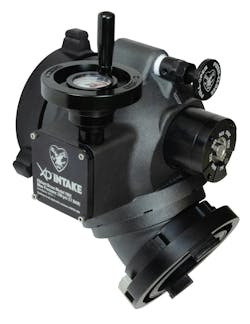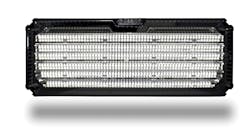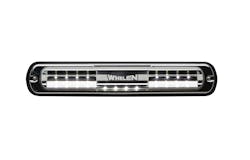Of the five apparatus equipment and components innovations that are reported on below, three are apparatus lighting products. Four of eight products that were examined in “Apparatus Innovations: The Continuing Evolution of Apparatus Equipment and Components,” which was published in the August 2024 issue of Firehouse, fell into the same category. Although the prevalence of apparatus lighting products in the two articles is coincidental, it certainly reflects the reality of the lighting industry and of the fire apparatus industry the past few years.
One reason for the regular advancement on the lighting side is that LED technology has improved in leaps and bounds. So has emergency and scene lighting. It seems that every few months, a new emergency or scene light fixture hits the market.
On the fire apparatus side, an inordinate amount of time is spent on lighting packages.
As a result of both circumstances, the nomenclature is evolving. Lumens is the new catch word, but raw lumens and effective lumens can confuse the matter.
There also is widespread belief that LEDs draw less power. This is true and false.
Better understanding of some of the technical aspects of LED lighting, primarily in scene lighting and an apparatus’ alternator, might save you heartache and repair bills in the future.
Lumens
What is a lumen? Lumens measure the amount of light that a light source emits. It has nothing to do with the power consumption of a particular light fixture. Power consumption varies greatly across the fixture’s operation voltage.
Raw lumens is a mathematical calculation, which usually is based on the output of a single LED diode that’s used in a fixture. Effective lumens are an indication of the light output of a fixture. However, numerous variables shape the quality of the light output and how good it is at its task.
The effective lumens output of a given light fixture usually is 10 percent to 30 percent less than the raw lumens rating. The difference can be as much as 40 percent less. Raw lumens are great for marketing but tell you little about the light’s performance.
LEDs and power consumption
It long has been touted that LED lights don’t draw as much power as their incandescent counterparts, and that’s true. A 12-volt, 55-watt halogen bulb that’s common to a 4 x 6-inch warning light fixture draws about 4.3 amps. The peak draw of an LED fixture of the same size is 1.1–1.4 amps, depending on the light manufacturer.
Although individual light fixtures have become less amperage-consuming, there’s a good chance that today’s apparatus include three or four times the number of warning light fixtures than that of apparatus of the past. Therefore, the gross amperage draw for a warning light package might be far greater than that of existing apparatus that were constructed in the past. That said, amperage draw realities and calculations become more critical when looking at high-output, 12-volt power scene lighting. Scene lighting that’s specified at 28,000 lumens at 12 volts DC draws about 20 amps each. The same lighting at 110 volts draw only 2.8 amps. Put six of those 12-volt lights on an apparatus and you create a 120-amp draws on the electrical system when the lights are activated. Most 360-amp alternators that are available on apparatus today produce 160–170 amps at idle and an operating temperature of 200 degrees Fahrenheit. In my evaluation of new and older pumpers that have modest emergency light packages, with the engine running and DOT lights, headlights, high beams, air conditioning and emergency warning lights operating, I have found draws of 95–130 amps. Yes, that’s well within the operational capabilities of a 360-amp alternator at idle—until you turn on high-output, 12-volt scene lights, at which point the draw exceeds what the alternator can produce, and the additional power is drawn from the vehicle’s batteries.
With comprehensive warning light packages, the amp draw on larger apparatus (read: more lights) increases. The high-idle button is your friend. Use it. However, more importantly, understand what you ask for on your apparatus and what the ramifications of those requests might be.
What about the NFPA?
New apparatus must pass a 12-volt system performance test. It’s identified in Chapter 10, Section 10.3 of NFPA 1900: Standard for Aircraft Rescue and Firefighting Vehicles, Automotive Fire Apparatus, Wildland Fire Apparatus, and Automotive Ambulances. Seven criteria are defined as mission-critical in the test process. Scene lighting isn’t one of the criteria. Don’t believe that because your apparatus passed the test procedure prior to delivery that you can leave the rig idle with every switch in the “on” position. Understand the system’s limits and the best ways to utilize it for needed operations without overloading it. Make sure that your apparatus operators are well trained and familiar with that.
Elkhart Brass
The 1902 XD intake valves are designed with today’s larger output pumps in mind. All versions of the valve terminate with a three-lug, 6-inch threaded swivel to attach to the pump. The valve is available in straight, low-profile and elbow configurations. All versions have a handwheel-operated open/closing mechanism that includes a dial-type valve position indicator. Valves are equipped with a field-adjustable pressure relief that has a stepped collar, which makes knowing the set pressure of the relief valve very easy. Critical, high-cycle components, including the pressure relief and the handwheel actuator, are of metal construction for reliability. The ultra-high-molecular-weight polyethylene seat, rather than a traditional rubber seat, provides enhanced durability and performance. Of the many characteristics of this material, those that are of interest to the fire service are a low coefficient of friction (to make the valve easier to open and close) and resistance to abrasion and corrosion. All valves are equipped with a push/pull drain valve and have various options for threaded and Storz inlet connections. Friction loss is at 2,000 gpm. Flow rate is 2 psi or less, depending on valve configuration.
Federal Signal
The PF400-Q siren has 400 watts of audio output, which doubles the 200-watt output that has long been the high-power standard for electronic sirens. Set up with four 100-watt audio output channels, the unit simultaneously powers both the electronic siren functions and the company’s Rumbler low-frequency siren. This eliminates the need for separate power units and control units, which reduces dashboard clutter and the mounting space that’s required for components.
A programable design that has several options for features and four different control heads can take this model from a simple siren control/public address system to a unit that also can control emergency and scene lighting. Powercall Siren tones also are available on the unit.
TecNiq
The E100 high-intensity (30,000 lumens) scene light has a side-to-side light pattern that spreads 80 degrees and a vertical light patten that spreads 105 degrees. The light is available in white and black housings. Three mounting choices are available: pole-mounted, surface-mounted and brow-mounted. The company says that more options are forthcoming.
Whelen Engineering
The Field Series is a new brow light that breaks the focus pattern into a near field zone and a far field zone. The lighting zones can be used separately or together, depending on what the on-scene need dictates. The length of the light ranges from 12 inches (two-lamp) to 78 inches (13-lamp). Depending on the mounting location and lighting that’s needed, it’s possible to mount the light in groups of two or three and interconnect them. (Thirteen lamps is the maximum load that can be put on a power supply.) There are five switching options for turning the light on; one is instant; on the other four are varying speeds, which is a feature that illuminates the light gradually, which is known as ramping on. The light housing is available in white and black.
The WorkSide vehicle-mounted, vehicle-perimeter scene light is designed to be easily mounted on virtually any rig and to illuminate the immediate perimeter of the vehicle. Compact in size, the fixture measures 14.2 inches wide, 2.3 inches high and just over 1 inch deep. To mount the fixture, three holes are required—two for #6 sheet metal screws and a 1-inch hole for wiring and connecting. The lighting pattern illuminates an area 10 x 10 feet and is directed downward.
About the Author

Jeffrey D. Gaskin
Jeffrey D. Gaskin is president of Big Red Trucks Fire Apparatus Consultants. He is a retired captain from the Scarsdale, NY, Fire Department. Throughout his career, Gaskin has been involved in apparatus acquisitions, from needs assessment through specification-writing. He also is a fire apparatus mechanic and holds certifications from Allison Transmission, Detroit Diesel, Hale Pump, Smart Power, Spartan Chassis, Sutphen Fire Apparatus and others. Gaskin is certified by the Emergency Vehicle Technician Certification Commission in six areas: Fire Apparatus Inspection, Maintenance and Testing (F-1); Design and Performance Standards of Fire Apparatus (F-2); Fire Pumps and Accessories (F-3); Aerial Fire Apparatus (F-5); Allison Automatic Transmission (F-6); and Hydraulic Systems (F-8). He can be reached at [email protected].




